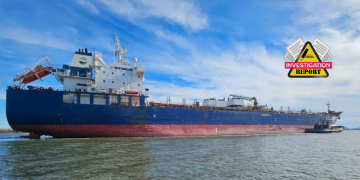IMCA highlights lessons learned from an incident during pipelaying operations, where a wooden packing block fell more than 10 meters from the pipelay tower and landed on the workstation floor.
During pipelaying operations, a wooden packing block (approx. 1kg) became attached to the pipe whilst spooling off the reel. It crossed the main deck and entered the pipelay tower with the pipe, where it became detached and fell more than 10m through the lay system before landing on the workstation floor. There were no injuries.
This was the first time a packing block had breached all barriers in the tower and landed in the workstation. Falling wooden blocks are expected during spooling operations, often falling into the spooler reeler basin. It is a known hazard, therefore operations are supported by risk controls such as barrier management and other safeguards.
What was the cause
Investigation revealed:
- The dropped object (wooden packing block), used for crossover packing on the spooler reel, had compressed into the parent coating of the pipe. It was thought that this was the mechanism that has transported the block on the pipe and into the lay system;
- The DROPS barriers on the workstation were inadequate to prevent a wooden block getting through the gap around the annulus of the pipe. The drops barrier is also susceptible to movement from pipe deflection without retracting with the pipe, and this could potentially widen the gap around the pipe. The dropped object passed through this gap and landed on the workstation floor. Had the barrier been suitable to restrict the size of the smallest packing block the incident would have been prevented.
Lessons learned
- Ensure all barriers are sufficient for the activities you are conducting;
- Ensure specific barriers (as in this case, around the pipe) are designed to minimise any gap to prevent the passing of potential dropped objects, whilst still allowing operations to proceed in a timely way;
- Ensure, so far as is possible, that there are no personnel in high risk/drops work areas;
- Be aware of risk normalisation and becoming accustomed to seeing unnecessarily dangerous situations in your workplace. Tolerating small defects or gaps in risk control can lead to major incidents;
- Consider new technologies available such as artificial intelligence using CCTV and alarms.





























































